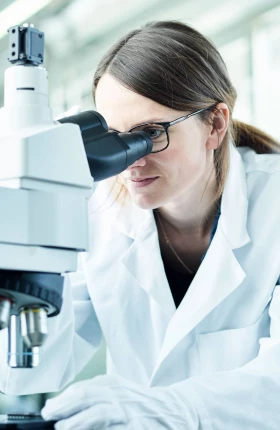As start-up ideas go, this has to be one of the best: Ajan Reginald wants to mend broken hearts.
Medically speaking, that is.
Heart disease affects about 30 million people globally, causes an estimated 4 million deaths per year in Europe, and is the primary cause of death in the developed world. Although modern medicines can provide a degree of relief, the harsh reality is that today there is no cure.
But there may be. Ajan (Chicago, Zurich, 2003-2005) is the founder and CEO of Cell Therapy Limited (CTL), a biotech firm he started in 2009 to experiment with stem cells as a way to fix damaged heart tissue.
“It was my dream to start a company that melds great science with great business to produce great benefits,” said Ajan.
It doesn’t hurt that his cofounder is Professor Sir Martin Evans, a Nobel laureate who first isolated and grew embryonic stem cells at Cambridge University back in the 1980s.
“Martin has a vast depth of understanding, expertise, and intuition, all of which are fantastic leadership qualities. But he also brings strong contributory assets that make him a brilliant person to start a company with,” said Ajan.
For the first six months, it was only the two of them. “We were a genuine start-up, doing everything ourselves: designing experiments, registering the company, raising funds, and setting up the website. We were certainly unique in that we had a Nobel Prize winner answering the phones.”
CTL has since identified a way to treat people with the most severely damaged hearts—those whose only hope is to receive a transplant.
“We’re treating people who have a life expectancy of less than one year—with 70 percent one-year mortality,” said Ajan.
And this is where the “great science” part of his dream comes in to play.
CTL’s proprietary cell therapy claims unique properties. “It’s a paradigm-shifting technology. Today’s medicines can only keep a patient from getting worse. We’re looking, for the first time, at a medicine that is able to regenerate a damaged organ.”
Heart failure develops after a person has a heart attack or when the arteries of a person’s heart are blocked. The heart muscle gets damaged and forms nonfunctioning scar tissue. Without treatment, this scar tissue expands, leading to heart failure and a significant chance of death within a few years.
CTL’s stem-cell therapy can be injected into scar tissue to reduce the size of the scar, stimulate repair, improve the heart’s ability to function, and mitigate the likelihood of heart failure.
Although there are other biotech firms working to produce stem cells for the broad treatment of diseases—using the same stem cell for, say, the treatment of lung disease or a chronic joint problem—CTL is unique in that it has been able to identify and isolate heart-specific stem cells.
The firm has already completed successful clinical trials, which brings us to Ajan’s vision of a “great business.”
The fast-growing high-tech stem-cell market is projected to reach about $20 billion in five years, and CTL hopes to tap into that market. Last year, in what was an unusual move for a biotech start-up, the firm ran an external fund-raising campaign that included crowdfunding; the goal was to raise £1 million. Ajan anticipated it would take up to three months to hit his target.
It took just ten days.
“The fact that we met our goal in such a short time shows that exceptional science for the benefit of society is an exciting investment proposition. This outcome is consistent with my BCG experience: clients with a focus first and foremost on quality produced highly differentiated products with demonstrable benefits, and profits followed. BCG gave me the analytical skills to understand these important drivers of great companies; hopefully I can replicate these characteristics in our small firm.”
In CTL’s case, demonstrating benefits demands a meticulousness in the way it generates value for heart patients. “Scrupulousness in value-generation for our patients translates into value-generation for our shareholders,” Ajan says.
In addition to Sir Martin Evans, CTL’s leadership team boasts other prominent figures, including Rhodri Morgan, a former first minister of Wales, Mubasher Sheikh, a former transplant surgeon and the current head of Permira health care, and Lord Digby Jones, a former UK minister of state for trade and development.
“It’s important to surround yourself with smart, critical people and to listen to them. Again, this is something I learned at BCG. I’m fortunate to have an exceptional board and executive team, and I am careful to listen, but ultimately I’m responsible for the decisions, good or bad. And I’m happy to make those calls.”
Ajan likens his role among these iconoclasts to his position as a central midfielder in field hockey. (He currently represents the England Masters at the international level.) “In other words,” he says, “I’m expected to see everything, anticipate everything, and cover every inch of the pitch. I’ve got to be a total team player—attacking, defending, and fulfilling whatever role is required by the team.”
“CTL is like most biotech companies in that it requires a CEO to understand and connect the science with the biotech business,” says Ajan. “However, where CTL may be different is the dual-fold novelty and ambiguity of both our field of regenerative medicine and CTL’s unique approach. The novel approach in an unproven field and being at the fore-front. There is no path to follow. Therefore, we believe an in-depth level of science and business expertise is necessary to make these critical (and novel) decisions.
“BCG was the best preparation for this role. I found my BCG experience very challenging and the hardest job I’ve ever done. But in hindsight, it was great training. The intellectual capacity needed, the speed of thought and execution required, and the unrelenting pressure and ‘stretch’ is how I developed my capacity to perform critical operations under high stress. BCG trained me to think and to work in a high-performance team. I learned to be data driven and to recognize excellent analysis and the singular value of insight from that analysis. Ultimately, leaving BCG was right for me. But the hard-won BCG skills gave me the ultimate confidence to use data to make the most critical decisions.
“My experiences from high-performance sports teams and BCG are complementary. High-level hockey is fast and dynamic; tactical thinking on the fly is very hard. But for me, the single well-executed tactical decision that wins the game is compelling. In contrast, business is more strategic and tactical, and there’s more time to think. However, it’s much more difficult to produce ‘game winners’ in business, and it’s much harder to build a high-performance team. That may be because the time frames are longer, prolonged years of rigor are required, and the rewards are less connected with actions.
“When we started CTL, we decided to combine the teamwork of high-performance sports with the strategy and execution required to excel in business. Therefore, our team is nontraditional—perhaps to match our nontraditional scientific approach.
All of which, he says, is borne out in the success of CTL.
“If your high-performance team can work synergistically, excellence is a more likely outcome—be it at BCG, international hockey, or a biotech firm. I truly believe there are few limitations on the productivity of such organizations. You also need luck, however, and then you just might develop the world’s first regenerative medicine.”
CTL, which is based in Cardiff in the UK, now has 30 employees, holds more than 100 patents, and is affiliated with labs at leading universities in Oxford, Toronto, Denmark, Greece, and China.
“Our goal is to treat 100,000 critically ill patients within the next five years,” Ajan concluded. “Realizing the great responsibility of lifesaving medicines, we focus on bringing Heartcel to market rapidly. It’s an amazing time—simultaneously frightening, humbling, and awe-inspiring.”





